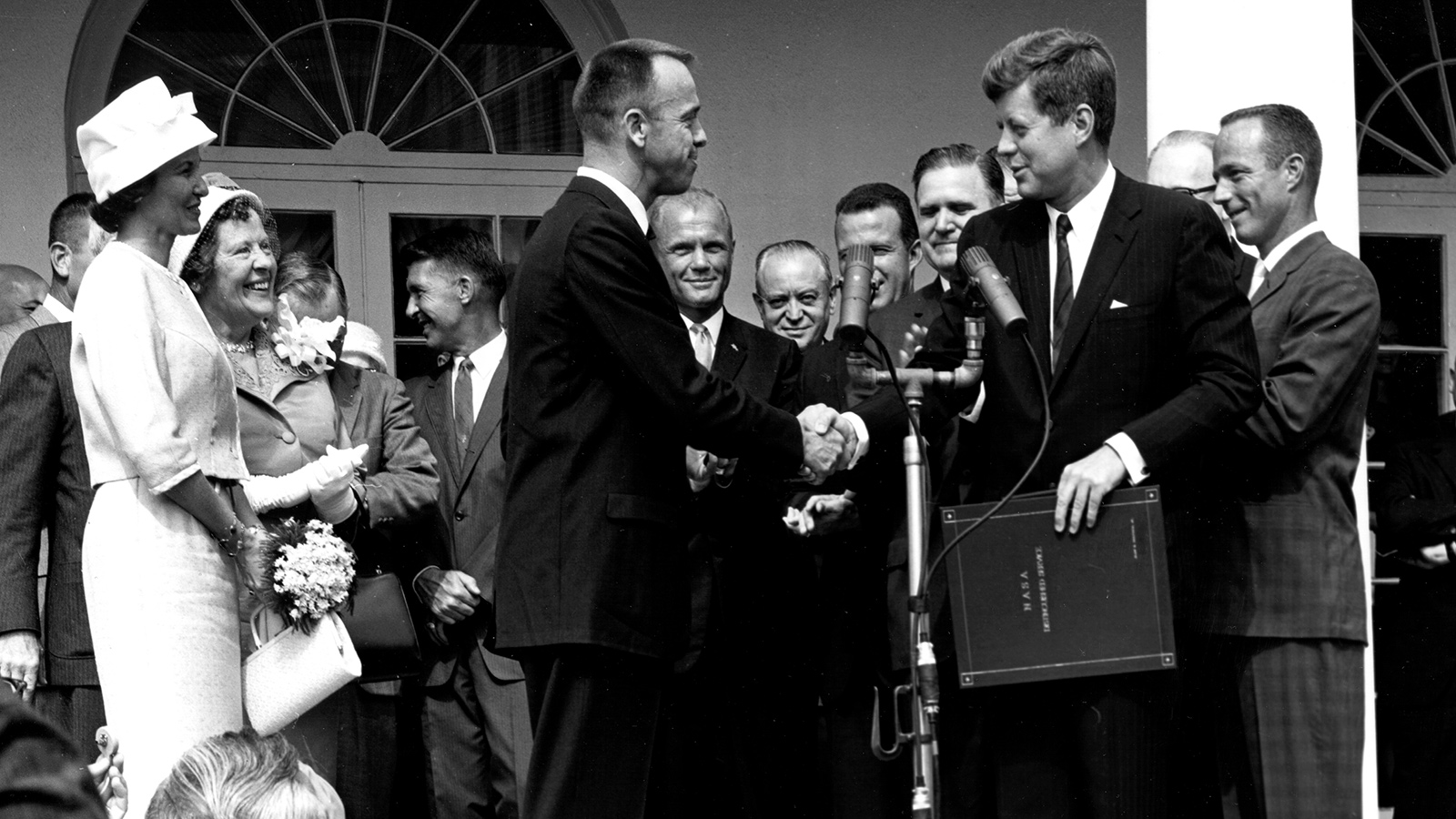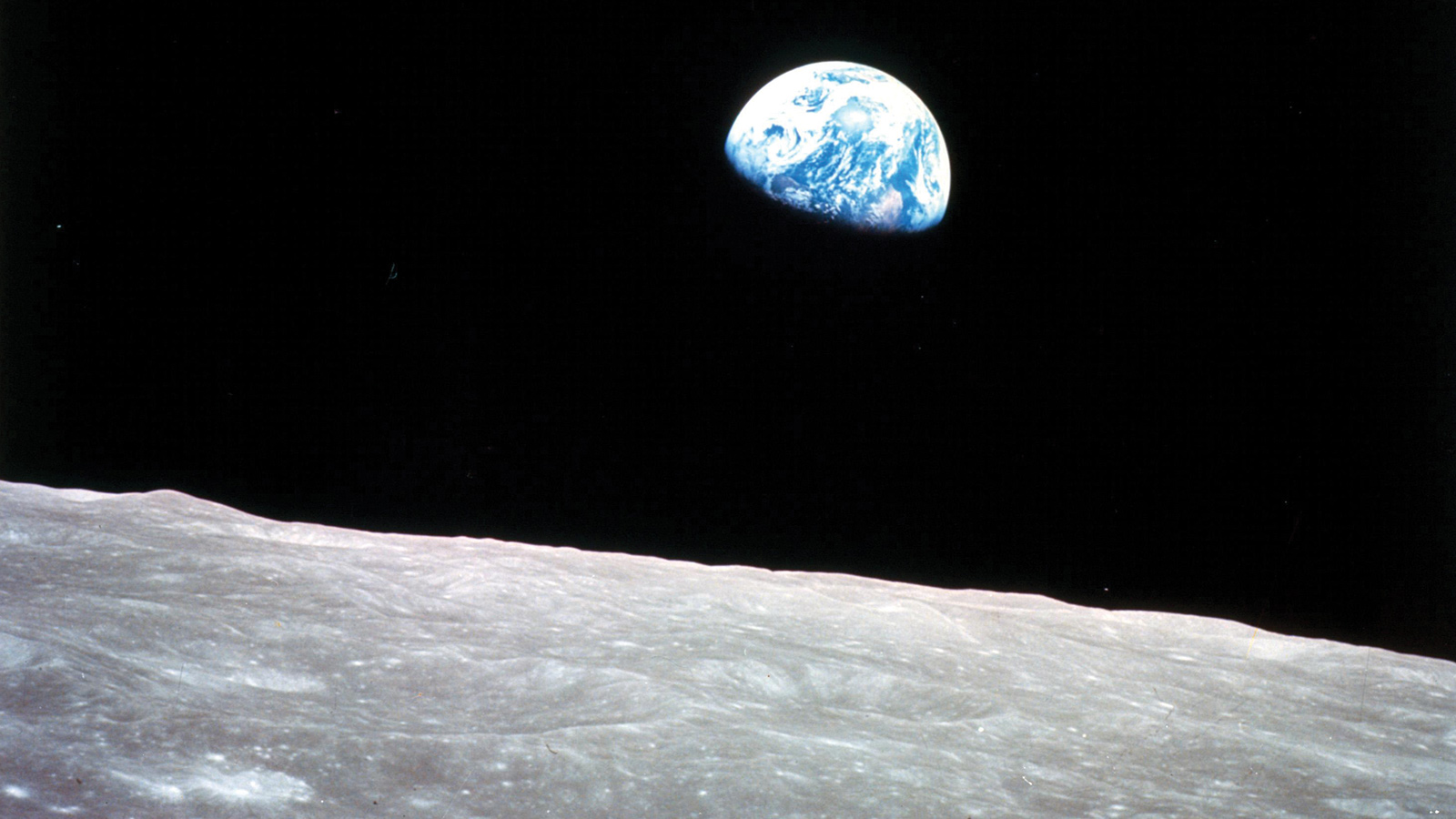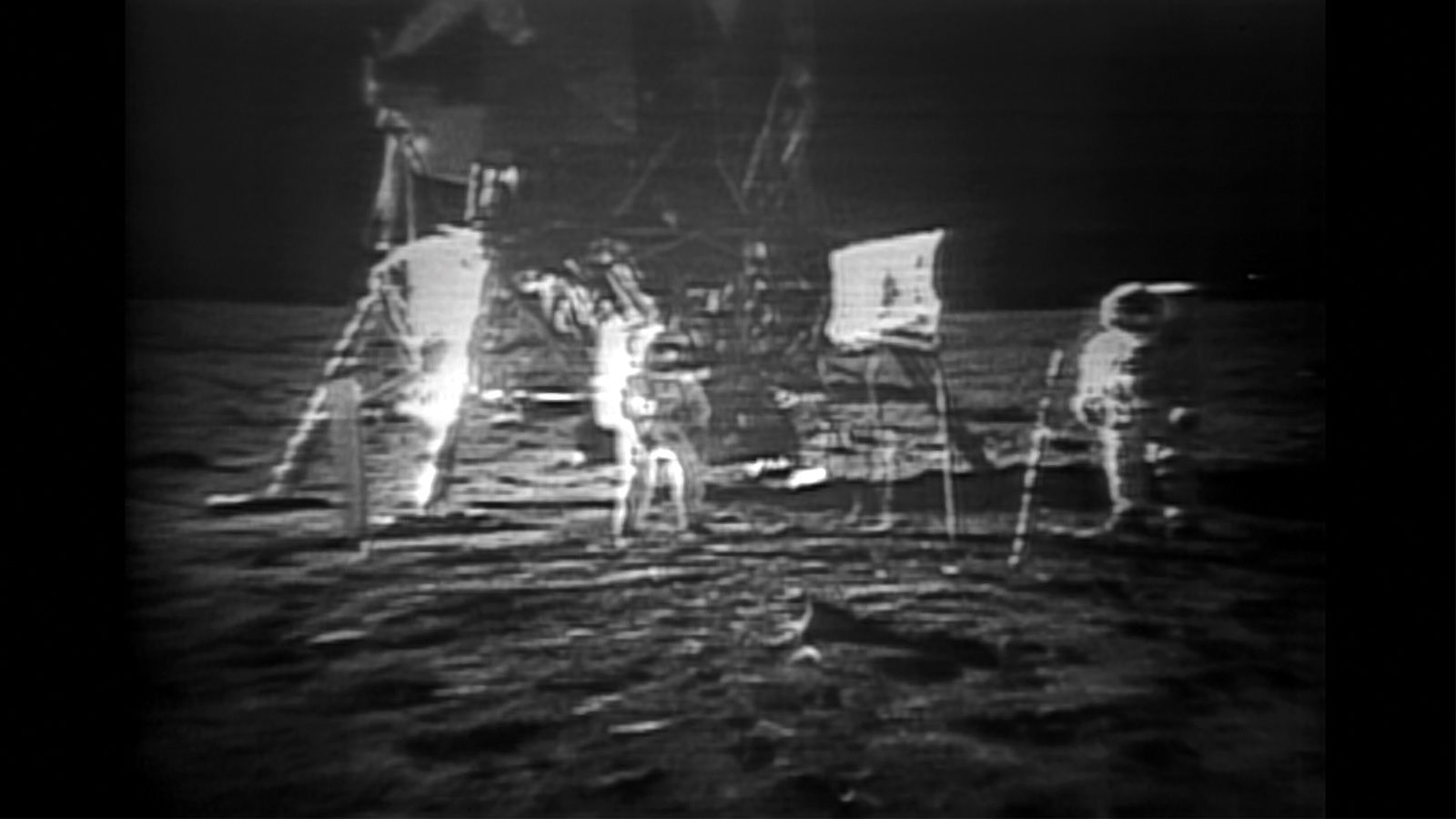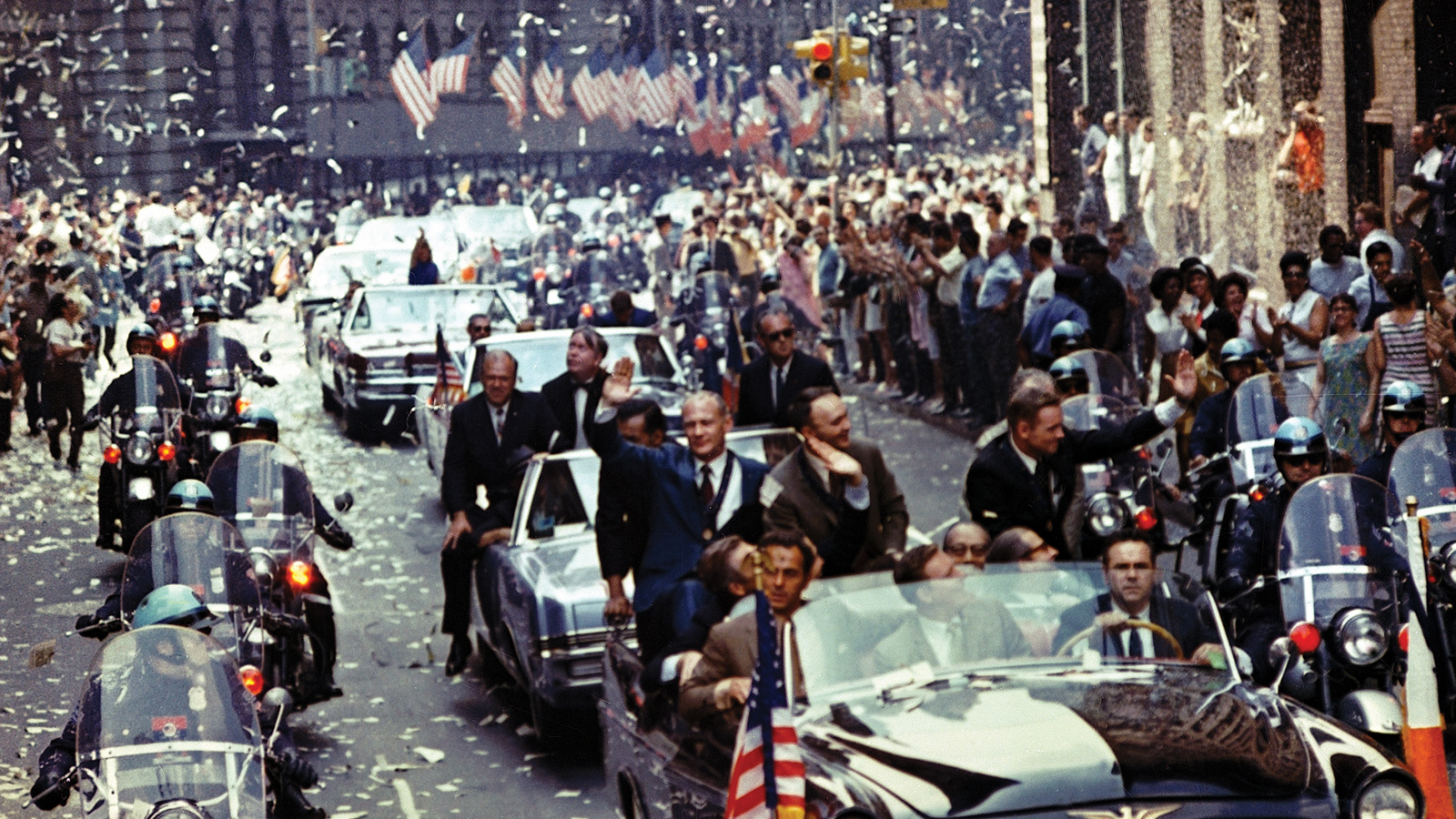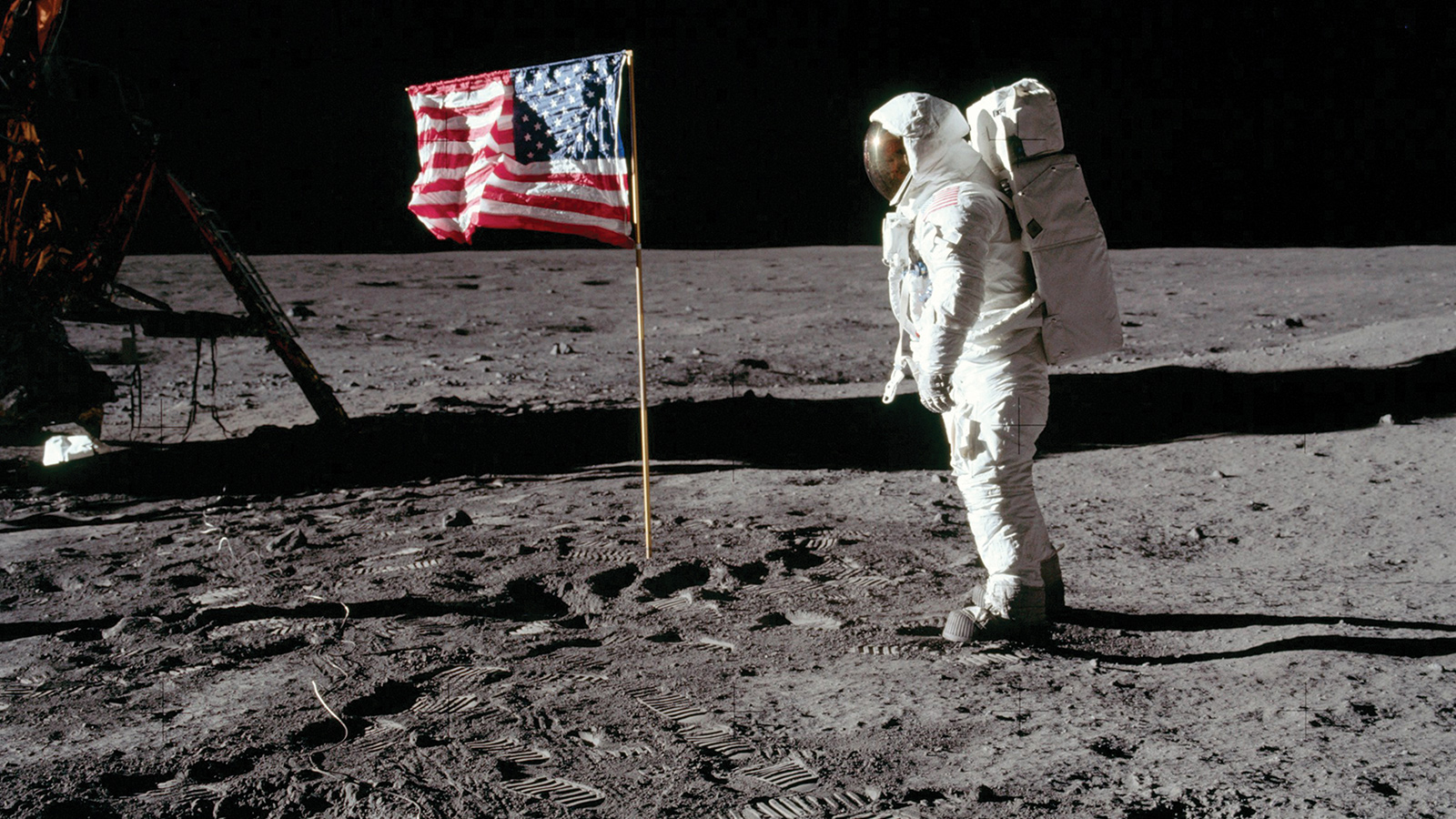Stay Up to Date
Submit your email address to receive the latest industry and Aerospace America news.
The Apollo 11 moon landing still amazes, not just as a technological achievement but as a feat of political will by a democratic society. Space scholar John Logsdon has spent a good part of his career thinking about why and how this bold mission succeeded. Logsdon depicts how the U.S. made what is arguably humanity’s greatest achievement.
On the early morning of July 16, 1969, I was one of a small crowd standing outside the Operations Building at Kennedy Space Center. At 6:27 a.m. Eastern time, a door opened, and Neil Armstrong, Mike Collins and Buzz Aldrin exited the building and strolled past us — on their way to the moon. Just over three hours later, at 9:32 a.m., I stood in the field in front of the press bleachers as the Saturn V carrying the Apollo 11 crew accelerated ever so slowly off of launch pad 39A. Nothing in my lifetime will compare to the combination of the physical experience of a Saturn V taking off plus knowing that I was experiencing history being made.
My involvement with Apollo began two years earlier. In 1967, I decided to write my doctoral dissertation in political science using President John F. Kennedy’s 1961 decision to send Americans to the moon as a case study of foreign policy decision-making. I had the good fortune of having access to many of Kennedy’s close associates. The dissertation soon turned into a book published in 1970, “The Decision to Go to the Moon.” The manuscript was completed by mid-1969, and that was what earned me an invitation to view the launch.
For me, the run-up to the 50th anniversary of the Apollo 11 mission has afforded an opportunity to tie together decades of research and thoughts about how the U.S. managed to win the race to the moon.
Why did we go?
Something that is often forgotten today is that Kennedy’s preference when he entered the White House in January 1961 was to work with the Soviet Union in space, with the aim of keeping it an arena for peaceful cooperation. Then the Soviet Union began preparations to launch MiG pilot Yuri Gagarin into orbit. When Kennedy went to bed on the evening of April 11, he was told that the launch would likely happen overnight; he was asked if he wanted to be woken if that indeed happened. His response was “no,” so he learned of Gagarin’s feat on the morning of April 12 and saw the Soviet Union being lauded. The Vatican newspaper characterized the achievement as a “universal good,” as Moscow claimed that it “embodied the genius of the Soviet people and the powerful force of socialism.” The Washington Post said the flight marked “a psychological victory of the first magnitude for the Soviet Union.” These reactions convinced Kennedy that he could not let the Soviet Union by default dominate outer space. He asked his advisers to identify “a space program that promises dramatic results in which we could win.” The answer came back — “go to the moon.” The U.S. and the Soviet Union would have to develop powerful new rockets, and the White House was told by Wernher von Braun that the country had an “excellent” chance of winning a rocket-building race.
Kennedy accepted this advice and on May 25, 1961, addressed a joint session of Congress, saying, “I believe that this nation should commit itself to achieving the goal, before this decade is out, of landing a man on the moon and returning him safely to Earth.”
Motivator in chief
Kennedy backed up his words with a massive, warlike but peaceful, mobilization of financial and human resources. Leaders of Congress were consulted in advance of Kennedy’s speech to make sure that they would approve funding for the mission. In the following weeks there was little congressional questioning of the wisdom of Kennedy’s proposal. Project Apollo became the largest U.S. technology-based project, surpassing the Panama Canal and the Manhattan Project. Apollo was assigned the highest government priority, and after Kennedy’s speech the NASA budget for fiscal year 1962 was increased by 89% over the previous year’s level, and another 101% the following year. By 1965, NASA’s budget was almost 5% of all government spending.
The NASA workforce doubled, and contractors working on Apollo increased fourfold. Although the average age of the Apollo workforce was 27, the project’s leaders, most of them in their 40s and 50s, brought extensive experience in managing large-scale military and aeronautics developments. (See box.) Chief engineer Max Faget helped design the Apollo spacecraft, and flight operations director Chris Kraft basically invented the methods that would guide that spacecraft to the moon and back. German émigré von Braun, now a U.S. citizen, led his rocket team in Huntsville, Alabama, and Florida. Many others in NASA, industry and academia made critical contributions to program success.
Another key to success was the clear and crisp goal that Kennedy had set, which combined a specific destination — the moon — and a precise deadline for getting there and safely back — “before this decade is out.” Without that deadline, arguments about how best to get to the moon could have dragged on. With the deadline, expeditious decisions were needed.
Early decisions
The choice of Houston as the location for a new Manned Spacecraft Center, announced in September 1961, was politically driven. Vice President Lyndon B. Johnson was a Texan, and even more importantly, Rep. Albert Thomas of Houston, who chaired the House committee that controlled NASA’s budget, made it clear that putting the facility in Houston was key to his support. By the end of that year, NASA had given the contract to build the Apollo command and service module to North American Aviation and had decided to add a fifth engine to the advanced version of von Braun’s Saturn design, making it the Saturn V. Boeing would build the booster’s first stage, North American the second stage and Douglas Aircraft the third stage, with Rocketdyne providing the rocket engines for all three stages.
In 1962, after much internal agonizing and over White House opposition to its technical judgment, NASA chose the lunar orbit rendezvous approach. A separate small spacecraft would detach from the command and service module in moon orbit. This lunar excursion module (later shortened to lunar module) would land on the moon; after the astronauts carried out surface activities, its ascent stage would lift off and rendezvous with the command module as it orbited the moon. After the moonwalkers and their cache of moon rocks transferred back to the mother ship, the ascent stage would be sent to crash on the lunar surface.
The contract for the lunar module was awarded to Grumman Aerospace in November 1962. The selection of this “mission mode” meant that only one Saturn V launch would be needed for each lunar voyage. Also in 1962, NASA acquired land on Merritt Island, Florida, adjacent to the Air Force-operated Cape Canaveral facility and began construction of Launch Complex 39, including the towering Vehicle Assembly Building. This would be the nation’s “moonport.” When the Apollo schedule in 1963 appeared in jeopardy, NASA, at human spaceflight head Mueller’s insistence and over the von Braun team’s opposition, adopted an “all up” approach to testing the Apollo-Saturn system. Booster and spacecraft elements would be tested together rather than separately. This decision saved many months in the Apollo schedule, making the “end-of-the-decade” goal achievable.
Second thoughts
By 1963, criticisms of Apollo had emerged, and future political support for the fast-paced effort was far from certain. Kennedy himself seems to have had second thoughts. In both 1962 and 1963 he requested in-depth reviews of the overall national space program. In a September 1963 speech at the United Nations, Kennedy returned to his original idea of space as an arena for peaceful cooperation, suggesting turning Apollo into a joint U.S.-Soviet undertaking. The idea was greeted with an ambiguous response from Nikita Khrushchev. Kennedy traveled to Texas in November, a few days after visiting Cape Canaveral, where he had seen a Saturn I on its launch pad and was told that it would give the U.S. the lead in lifting power. Kennedy’s excitement about going to the moon seemed reenergized, after he wavered earlier in the year with his call for review of the program. He told a San Antonio audience: “This nation has tossed its cap over the wall of space, and we have no choice but to follow it.” The next day, Nov. 22, he traveled to Dallas, where he was assassinated.
It is impossible to say what might have happened if Kennedy had lived to complete two terms in the White House. He may have continued to push for cooperation, turned off the “end-of-the-decade” deadline, or continued along the planned path. But after Kennedy’s death, achieving the Apollo goal quickly became a memorial to a fallen young president. Even after the Apollo 1 launch-pad fire in 1967 killed astronauts Gus Grissom, Roger Chaffee and Ed White, there was no thought given to abandoning the push to the moon. Unfortunately, it was Kennedy’s death that was the final key to being first to the moon.
In contrast to the U.S. Apollo triumphs that unfolded after Kennedy’s death, the Soviet lunar program was beset by internal bureaucratic and personal rivalries, the lack of both adequate resources and centralized leadership, and the 1966 death during surgery of the charismatic Soviet “chief designer,” Sergei Korolev. Even so, the Russian program came close to getting to the moon before the United States. At the end of 1968, only a last-minute Kremlin decision aborted a plan to send cosmonauts looping around the moon before Apollo 8. Before Apollo 11 was launched in July 1969, two attempts to test their massive N-1 booster, the Soviet equivalent of the Saturn V moon rocket, failed, with one accident severely damaging the booster’s launch pad. The United States won the race to the moon, and a race it was.
“One giant leap for mankind”
When in 1961 Kennedy decided to send Americans to the moon, he wanted to impress on the people of the world that, despite Soviet claims to the contrary, the United States remained the global leader in technological and military power and the nation most worth emulating.
Apollo was an exercise in propaganda — sending to the world, and ourselves, a message of American superiority and exceptionalism.
Kennedy’s advisers told him that the prestige from being first to the moon would be “part of the battle along the fluid front of the Cold War.”
It is doubtful, at least at its inception, that Kennedy saw his Cold War initiative in broad historical terms. But as I wrote in 1970, “the politics of the moment had become linked with the dream of centuries.” Humans from varied civilizations around the globe had made traveling to the moon a central theme in their stories about the future; now, at the end of the 1960s, the United States intended to make that mythical voyage a reality.
That Apollo would have a global impact that transcended its Cold War origins became evident as the Apollo 8 crew entered lunar orbit on Christmas Eve 1968. As the crew read from the Bible and sent back contrasting images of the barren lunar surface and the cloud-streaked, ocean-covered Earth, the American poet Archibald MacLeish was prompted to write: “To see the Earth as it truly is, small and blue and beautiful in that eternal silence where it floats, is to see ourselves as riders on the Earth together, brothers on that bright loveliness in the eternal cold — brothers who know now they are truly brothers.” Praise for the Apollo 8 mission flooded the White House and NASA from both the world’s leaders and the general public. Soon after, the “Earthrise” photo taken by Apollo 8 crew member Bill Anders was published and immediately achieved iconic status.
The exultant worldwide reaction to the Apollo 8 success reminded U.S. leaders, if they needed reminding, that the first steps on the moon a few months later would be celebrated as a global event. It would be crucial to the political success of the mission to craft words and images that recognized that reality.
The first landing attempt could come with the mid-July Apollo 11 mission. The crew for that mission, announced on Jan. 9, 1969, would be Armstrong, Aldrin and Collins. From that day on, there was recognition that their names would be certain to go down in history. It soon became known that Armstrong, the mission’s commander, would take the first steps on the lunar surface. One early NASA decision was that what Armstrong would say as he stepped on the moon would not be scripted in advance; those words would be Armstrong’s personal choice.
His brief statement — “That’s one small step for man, one giant leap for mankind” — ended up fitting the moment perfectly.
What of a symbolic character Armstrong and Aldrin would do in their just over two hours on the lunar surface was carefully considered at NASA’s top levels; the result was a success story in message shaping. A NASA “Symbolic Activities Committee” decided that the objective of what was done on the moon was to portray “the first lunar landing as an historic first step of all mankind that has been accomplished by the United States of America.” To achieve the “all mankind” part of this message, a plaque would be attached to the part of the lunar module that would remain on the moon. That plaque would show “the two hemispheres of the Earth and the outlines of the continents, without national boundaries”; it would say “Here men from planet Earth first set foot upon the moon. We came in peace for all mankind.”
To show that it was the United States which had reached the moon, the astronauts would plant an American flag (and no other) in the lunar soil “in such a way as to make it clear that the flag symbolized the fact that an effort by the American people reached the moon, not that the U.S. is ‘taking possession’ of the moon.” There was a White House suggestion that the U.S. national anthem be played after the flag was planted, but that idea was quickly rejected. Armstrong did snap a photograph of Buzz Aldrin saluting the flag, and that photo, like Apollo 8’s “Earthrise,” became a lasting icon of Apollo’s achievement.
In a fortunate coincidence of technological progress, the third Intelsat communications satellite that would make possible global viewing of the first steps on the moon was put in service only 19 days before the Apollo 11 landing on July 20, 1969. The 3:18 p.m. landing, Houston time, was not broadcast live, but hours later some 600 million people, about one-fifth of the world’s population, watched on a Sunday evening in the U.S. as the ghostly image of Armstrong descended the ladder on the side of the lunar module. At 9:56 p.m. he took humanity’s first step on another celestial surface. Armstrong was joined 19 minutes later by Aldrin. The two spent about two hours on the moon’s surface, described by Aldrin as “magnificent desolation,” collecting rock and soil samples, taking photographs, carrying out the planned symbolic activities, and taking a brief phone call from President Richard Nixon in the White House. Orbiting overhead in the Apollo command module was Collins. Mission Control in Houston reminded him “you’re about the only person around that doesn’t have TV coverage of the scene”; Collins responded, “That’s all right. I don’t mind a bit.” The televised moon walks were perhaps the first instance of what historian Daniel Boorstin would later characterize as “shared public discovery.”
The impact of the Apollo 11 landing was immediate, global and positive. Even today, most people who were old enough to understand what was happening can tell you where they were when Armstrong and Aldrin walked on the moon. Streets around the world were quiet as people crowded around television sets and radios. Newspapers around the world hailed the achievement in banner headlines. Two months after the Apollo 11 crew returned to Earth, the White House sent them on a 39-day, 24-country tour. Throughout their journey, the crew heard over and over the words “we did it,” with the “we” being humanity, not just the United States. There was almost universal identification with the moon voyage and admiration for the nation that had carried it out.
Can there be another “Kennedy moment”?
It is important to recognize the Apollo 11 achievement for what is was — and what it was not. Apollo neither solved the national rivalries of the 20th century by translating a brief transcendent moment into lasting political harmony, nor (at least so far) began the movement of humanity off its home planet. By the way that Apollo 11 was framed, the global reaction was one of excitement and inspiration; the superpower rivalry that had fueled Apollo was pushed to the background. Apollo achieved Kennedy’s goal of sending a message of U.S. exceptionalism and power to the world in a way that engaged, rather than threatened, others. While the immediate impact of the lunar landing quickly dissipated, it left a lasting legacy of admiration for the country that could carry off such a feat and a lingering sense of pride among Americans that underpins this year’s Apollo celebrations.
The circumstances of Apollo were unique, and for that reason the experience has little to teach us about the conduct of future space endeavors beyond reminding us that once, a half century ago, we did indeed go to the moon. Today’s initiative to resume lunar voyages will have to find its own path to success.
More than three centuries before Armstrong and Aldrin left their footprints on the lunar surface, British clergyman, polymath and author John Wilkins wrote: “It is likely enough that there will be a means invented of journeying to the moon. And how happy they shall be who are first successful in this attempt.” As we look back on Apollo 11, we should recognize that we indeed are joined in celebrating a “happy” moment in humanity’s history. Whatever the future of human exploration of space, that moment is certain to be remembered for centuries to come.
THE BEST AND THE BRIGHTEST
Managing Apollo matters overall in Washington, D.C., were NASA Administrator James Webb, Deputy Administrator Hugh Dryden and Associate Administrator Robert Seamans. Human spaceflight head George Mueller and Apollo program manager Air Force Gen. Sam Phillips bridged the gap between maintaining political support for Apollo and providing wise technical direction. In Houston, Robert Gilruth, the director of the new Manned Spacecraft Center, had been in charge of NASA’s human spaceflight efforts since the agency’s inception in 1958. His deputy, George Low, had been one of those most involved in 1961 in telling the White House that Apollo was technically doable. Throughout Apollo, Low’s technical judgments proved crucial to the success of the effort.
About John M. Logsdon
John M. Logsdon is professor emeritus at George Washington University and has written books on the space policies of U.S. Presidents Kennedy, Nixon and Reagan. He founded GW’s Space Policy Institute in 1987 and directed it until 2008. Logsdon was a member of the Columbia Accident Investigation Board. He has a doctorate in political science from New York University and a Bachelor of Science in physics from Xavier University. He is editor of “The Penguin Book of Outer Space Exploration.”
Related Posts
Stay Up to Date
Submit your email address to receive the latest industry and Aerospace America news.


